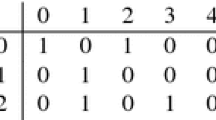Abstract
The complex Langevin method is a leading candidate for solving the so-called sign problem occurring in various physical situations. Its most vexing problem is that sometimes it produces ‘convergence to the wrong limit’. In this paper we carefully revisit the formal justification of the method, identifying points at which it may fail and derive a necessary and sufficient criterion for correctness. This criterion is, however, not practical, since its application requires checking an infinite tower of identities. We propose instead a practical test involving only a check of the first few of those identities; this raises the question of the ‘sensitivity’ of the test. This sensitivity as well as the general insights into the possible reasons of failure (the etiology) are then tested in two toy models where the correct answer is known. At least in those models the test works perfectly.
Similar content being viewed by others
References
P. de Forcrand, Proc. Sci. LAT2009, 010 (2009). 1005.0539 [hep-lat]
J. Klauder, Acta Phys. Austriaca Suppl. XXXV, 251 (1983)
J. Klauder, J. Phys. A, Math. Gen. 16, L317–L319 (1983)
J. Klauder, Phys. Rev. A 29, 2036–2047 (1984)
G. Parisi, Phys. Lett. B 131, 393 (1983)
F. Karsch, H.W. Wyld, Phys. Rev. Lett. 55, 2242 (1985)
P.H. Damgaard, H. Hüffel, Phys. Rep. 152, 227 (1987)
J. Berges, I.-O. Stamatescu, Phys. Rev. Lett. 95, 202003 (2005). hep-lat/0508030
J. Berges, S. Borsanyi, D. Sexty, I.O. Stamatescu, Phys. Rev. D 75, 045007 (2007). hep-lat/0609058
J. Berges, D. Sexty, Nucl. Phys. B 799, 306 (2008). 0708.0779 [hep-lat]
G. Aarts, I.-O. Stamatescu, J. High Energy Phys. 0809, 018 (2008). 0807.1597 [hep-lat]
G. Aarts, Phys. Rev. Lett. 102, 131601 (2009). 0810.2089 [hep-lat]
G. Aarts, J. High Energy Phys. 0905, 052 (2009). 0902.4686 [hep-lat]
G. Aarts, F.A. James, E. Seiler, I.O. Stamatescu, Phys. Lett. B 687, 154 (2010). 0912.0617 [hep-lat]
G. Aarts, F.A. James, J. High Energy Phys. 1008, 020 (2010). 1005.3468 [hep-lat]
G. Aarts, K. Splittorff, J. High Energy Phys. 1008, 017 (2010). 1006.0332 [hep-lat]
J. Ambjorn, S.K. Yang, Phys. Lett. B 165, 140 (1985)
J.R. Klauder, W.P. Petersen, J. Stat. Phys. 39, 53 (1985)
H.Q. Lin, J.E. Hirsch, Phys. Rev. B 34, 1964 (1986)
J. Ambjorn, M. Flensburg, C. Peterson, Nucl. Phys. B 275, 375 (1986)
G. Aarts, E. Seiler, I.O. Stamatescu, Phys. Rev. D 81, 054508 (2010). 0912.3360 [hep-lat]
G. Guralnik, C. Pehlevan, Nucl. Phys. B 822, 349 (2009). 0902.1503 [hep-lat]
M. Reed, B. Simon, Functional Analysis, vol. I. (Academic Press, New York, 1972)
E. Seiler, Untersuchung eines selbstgekoppelten relativistischen Skalarfeldes mit Funktionalmethoden. Doctoral thesis, Technische Universität München (1971, unpublished) (in German)
C. Pehlevan, G. Guralnik, Nucl. Phys. B 811, 519 (2009). 0710.3756 [hep-th]
E.B. Davies, Linear Operators and their Spectra (Cambridge University Press, Cambridge, 2007)
W.H. Press et al., Numerical Recipes in Fortran 77—The Art of Scientific Computing, 2nd edn. (Cambridge University Press, Cambridge, 1992). Ch. 19
Author information
Authors and Affiliations
Corresponding author
Rights and permissions
About this article
Cite this article
Aarts, G., James, F.A., Seiler, E. et al. Complex Langevin: etiology and diagnostics of its main problem. Eur. Phys. J. C 71, 1756 (2011). https://doi.org/10.1140/epjc/s10052-011-1756-5
Received:
Revised:
Published:
DOI: https://doi.org/10.1140/epjc/s10052-011-1756-5




